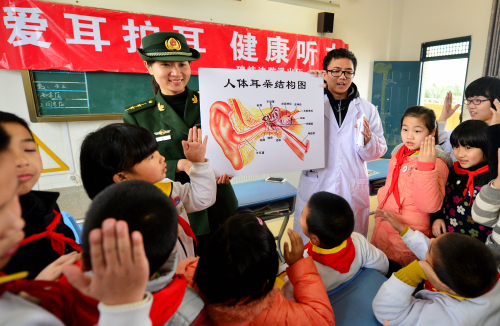|
 |
|
WHAT'S IN AN EAR: A doctor teaches children from Huaqiao Primary School in Fuzhou, Fujian Province, about the structure of the human ear on March 3, Ear Care Day (WEI PEIQUAN) |
More Public Servants
Northwest China's Xinjiang Uygur Autonomous Region has promoted 2,138 public servants in the past month, local authorities said on February 27.
Over the past three years, Xinjiang has sent a staggering 200,000 civil servants to its rural areas to help improve the quality of life of residents. This is part of a wider push by the regional government to give city officials experience in the country's underdeveloped areas.
Last March, the first 70,000 cadres from government departments, public institutions and state-owned enterprises were assigned to one-year posts in 8,636 villages; 759 branches of state farms; and 931 communities.
Zhang Chunxian, Party Chief of Xinjiang, said the cadres had achieved extraordinary results in their placements and really made a difference in villagers' quality of life.
According to the regional CPC committee, 2.26 billion yuan ($367.7 million) has been allocated to finance the building of roads, power networks, water facilities, as well as residential renovation projects.
The next round of 70,000 public servants will start their placements in rural areas soon.
Mine Safety Concerns
The State Administration of Work Safety vowed on March 4 to close at least 5,000 small mines, which is equal to 5 percent of the nation's total, to reduce the number of accidents and fatalities in 2015.
A 2007 regulation defines serious accidents as those causing 10 to 30 deaths, 50 to 100 serious injuries, or direct economic losses of between 50 million yuan ($8.13 million) and 100 million yuan ($15.87 million).
Extremely serious accidents are classified as those that kill more than 30 people, seriously injure 100, or cost more than 100 million yuan ($15.87 million) in losses.
Many small mines were lambasted by the administration for using substandard technology and equipment, which made them hazardous.
There were 269,000 accidents nationwide in the first 11 months of 2014, down 4.7 percent from the same period in 2013. Fatalities dropped by 6.1 percent to 57,000.
As of the end of 2014, China had seven national mine accident rescue teams, 14 regional rescue teams, 16 rescue teams established by state-owned companies and 10 rescue training centers, according to Yang.
Cultural Relic Census
The State Administration of Cultural Heritage announced on March 2 that a nationwide census has registered 45 million pieces of "moveable" cultural relics--a category that excludes architecture, large statues, etc.--after surveying more than 1.02 million state organizations.
Launched in 2012, the ongoing project is China's first survey of cultural relics. The information collected will be uploaded to an online database.
Li Xiaojie, head of the administration, said the database will be made available to the public.
The survey currently only includes relics owned by state organizations. Those in the hands of private collectors will be surveyed after the project's completion in 2016. | 